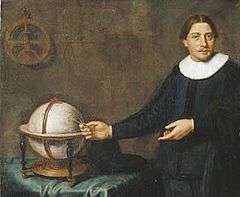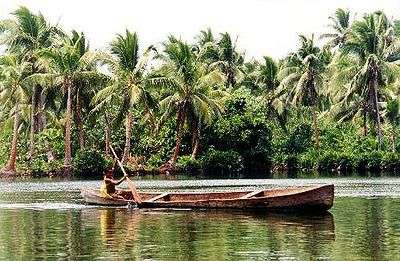Abel Tasman
| Abel Tasman | |
|---|---|
|
| |
| Born |
1603 Lutjegast, Netherlands |
| Died |
10 October 1659 (aged 55–56) Batavia, Dutch East Indies |
| Nationality | Dutch |
| Occupation | Navigator, explorer sea captain |
| Spouse(s) |
Claesgie Heyndrix Jannetje Tjaers = Joanna Tiercx |
| Children | a daughter Claesje |
Abel Janszoon Tasman (Dutch: [ˈɑbəl ˈjɑnsoːn ˈtɑsmɑn]; 1603 – 10 October 1659) was a Dutch seafarer, explorer, and merchant, best known for his voyages of 1642 and 1644 in the service of the Dutch East India Company (VOC). He was the first known European explorer to reach the islands of Van Diemen's Land (now Tasmania) and New Zealand, and to sight the Fiji islands.
First Pacific voyage
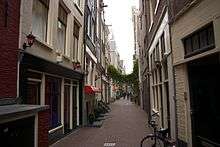
Abel Jans Tasman was born in 1603 in Lutjegast, a small village in the province of Groningen, in the north of the Netherlands. The oldest available source mentioning him dates 27 December 1631 when, as a seafarer living in Amsterdam, the 28-year-old became engaged to marry 21-year-old Jannetje Tjaers from the Jordaan district of the city.[3][4] In 1633 he sailed from Texel to Batavia in the service of the Dutch East India Company (VOC), taking the southern Brouwer Route. Tasman took part in a voyage to Seram Island; the locals had sold spices to others than the Dutch. He had a narrow escape from death, when in an incautious landing several of his companions were killed by people of Seram.[5] In August 1637 he was back in Amsterdam, and the following year he signed on for another ten years and took his wife with him to Batavia. On 25 March 1638 he tried to sell his property in the Jordaan, but the purchase was cancelled. In 1639 he was second-in-command of an exploration expedition in the north Pacific under Matthijs Quast. The fleet included the ships Engel and Gracht and reached Fort Zeelandia (Dutch Formosa) and Deshima.
In August 1642, the Council of the Indies, consisting of Antonie van Diemen, Cornelis van der Lijn, Joan Maetsuycker, Justus Schouten, Salomon Sweers, Cornelis Witsen, and Pieter Boreel in Batavia despatched Tasman and Franchoijs Visscher on a voyage of which one of the objects was to obtain knowledge of "all the totally unknown provinces of Beach".[6] This expedition used two small ships, the Heemskerck and the Zeehaen.
Beach and Terra Australis

Beach appeared on maps of the time, notably that of Abraham Ortelius of 1570 and that of Jan Huygen van Linschoten of 1596, as the northernmost part of the southern continent, the Terra Australis, along with Locach. According to Marco Polo, Locach was a kingdom where gold was “so plentiful that no one who did not see it could believe it”. Beach was in fact a mistranscription of Locach. Locach was Marco Polo’s name for the southern Thai kingdom of Lavo, or Lop Buri, the “city of Lavo”, (ลพบุรี, after Lavo, the son of Rama in Hindu mythology).[7] In Chinese (Cantonese), Lavo was pronounced “Lo-huk” (羅斛), from which Marco Polo took his rendition of the name.[8] In the German cursive script, “Locach” and “Boeach” look similar, and in the 1532 edition of Marco Polo’s Travels his Locach was changed to Boëach, later shortened to Beach.[9]
They seem to have drawn on the map of the world published in Florence in 1489 by Henricus Martellus, in which provincia boëach appears as the southern neighbour of provincia ciamba. Book III of Marco Polo’s Il Milione described his journey by sea from China to India by way of Champa (= Southern Vietnam), Java (which he called Java Major), Locach and Sumatra (called Java Minor). After a chapter describing the kingdom of Champa there follows a chapter describing Java (which he did not visit himself).[10] The narrative then resumes, describing the route southward from Champa toward Sumatra, but by a slip of the pen the name “Java” was substituted for “Champa” as the point of departure, locating Sumatra 1,300 miles to the south of Java instead of Champa. Locach, located between Champa and Sumatra, was likewise misplaced far to the south of Java, by some geographers on or near an extension of the Terra Australis.[11]
As explained by Sir Henry Yule, the editor of an English edition of Marco Polo’s Travels: “Some geographers of the 16th century, following the old editions which carried the travellers south-east of Java to the land of “Boeach” (or Locac), introduced in their maps a continent in that situation”.[12] Gerard Mercator did just that on his 1541 globe, placing Beach provincia aurifera (“Beach the gold-bearing province”) in the northernmost part of the Terra Australis in accordance with the faulty text of Marco Polo’s Travels.
It remained in this location on his world map of 1569, with the amplified description, quoting Marco Polo, Beach provincia aurifera quam pauci ex alienis regionibus adeunt propter gentis inhumanitatem (“Beach the gold-bearing province, whither few go from other countries because of the inhumanity of its people”) with Lucach regnum shown somewhat to its south west.[13] Following Mercator, Abraham Ortelius also showed BEACH and LVCACH in these locations on his world map of 1571. Likewise, Linschoten’s very popular 1596 map of the East Indies showed BEACH projecting from the map’s southern edge, leading (or misleading) Visscher and Tasman in their voyage of 1642 to seek Beach with its plentiful gold in a location to the south of the Solomon Islands somewhere between Staten Land near Cape Horn and the Cape of Good Hope.[14]
Confirmation that land existed where the maps showed Beach to be had come from Dirk Hartog’s landing in October 1616 on its west coast, which he called Eendrachtsland after the name of his ship.
Mauritius

In accordance with Visscher's directions, Tasman sailed from Batavia on 14 August 1642[15] and arrived at Mauritius on 5 September 1642, according to the captain's journal.[16] The reason for this was the crew could be fed well on the island; there was plenty of fresh water and timber to repair the ships. Tasman got the assistance of the governor Adriaan van der Stel. Because of the prevailing winds Mauritius was chosen as a turning point. After a four-week stay on the island both ships left on 8 October using the Roaring Forties to sail east as fast as possible. (No one had gone as far as Pieter Nuyts in 1626/27.) On 7 November snow and hail influenced the ship's council to alter course to a more north-eastern direction,[17] expecting to arrive one day at the Solomon Islands.
Tasmania
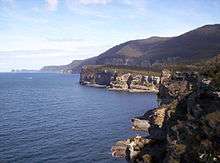
On 24 November 1642 Abel Tasman reached and sighted the west coast of Tasmania, north of Macquarie Harbour.[18] He named his discovery Van Diemen's Land after Antonio van Diemen, Governor-General of the Dutch East Indies. Proceeding south he skirted the southern end of Tasmania and turned north-east. Tasman then tried to work his two ships into Adventure Bay on the east coast of South Bruny Island where he was blown out to sea by a storm. This area he named Storm Bay. Two days later Tasman anchored to the north of Cape Frederick Hendrick just north of the Forestier Peninsula. Tasman then landed in Blackman Bay – in the larger Marion Bay. The next day, an attempt was made to land in North Bay. However, because the sea was too rough the carpenter swam through the surf and planted the Dutch flag. Tasman then claimed formal possession of the land on 3 December 1642.[19]
New Zealand


After some exploration, Tasman had intended to proceed in a northerly direction but as the wind was unfavourable he steered east. Tasman endured a very rough journey from Tasmania to New Zealand. In one of his diary entries Tasman credits his compass, claiming it was the only thing that kept him alive. On 13 December they sighted land on the north-west coast of the South Island, New Zealand, becoming the first Europeans to do so.[21] Tasman named it Staten Landt on the assumption that it was connected to an island (Staten Island, Argentina) at the south of the tip of South America. He sailed north, then east and five days later anchored about 7 km from the coast. He sent ship's boats to gather water, but one of his boats was attacked by Māori in a double hulled waka (canoe) and four of his men were attacked and killed by mere.
"In the evening about one hour after sunset we saw many lights on land and four vessels near the shore, two of which betook themselves towards us. When our two boats returned to the ships reporting that they had found not less than thirteen fathoms of water, and with the sinking of the sun (which sank behind the high land) they had been still about half a mile from the shore. After our people had been on board about one glass, people in the two canoes began to call out to us in gruff, hollow voices. We could not in the least understand any of it; however, when they called out again several times we called back to them as a token answer. But they did not come nearer than a stone’s shot. They also blew many times on an instrument, which produced a sound like the moors’ trumpets. We had one of our sailors (who could play somewhat on the trumpet) play some tunes to them in answer."[16]
As Tasman sailed out of the bay he observed 22 waka near the shore, of which "eleven swarming with people came off towards us." The waka approached the Zeehaen which fired and hit a man in the largest waka holding a small white flag. Canister shot also hit the side of a waka.[16][22]
Archeological research has shown the Dutch had tried to land at a major agricultural area, which the Māori may have been trying to protect.[23] Tasman named the bay Murderers' Bay (now known as Golden Bay) and sailed north, but mistook Cook Strait for a bight (naming it Zeehaen's Bight). Two names he gave to New Zealand landmarks still endure, Cape Maria van Diemen and Three Kings Islands, but Kaap Pieter Boreels was renamed by Cook 125 years later to Cape Egmont.
The return voyage
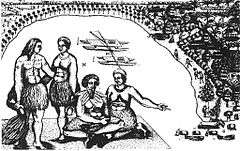
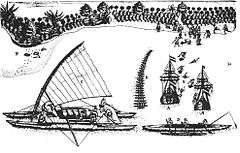
En route back to Batavia, Tasman came across the Tongan archipelago on 20 January 1643. While passing the Fiji Islands Tasman's ships came close to being wrecked on the dangerous reefs of the north-eastern part of the Fiji group. He charted the eastern tip of Vanua Levu and Cikobia before making his way back into the open sea. He eventually turned north-west to New Guinea, and arrived at Batavia on 15 June 1643.[19]
Second Pacific voyage
Tasman left Batavia on January 30, 1644 on his second voyage with three ships (Limmen, Zeemeeuw and the tender Braek). He followed the south coast of New Guinea eastwards in an attempt to find a passage to the eastern side of New Holland. However, he missed the Torres Strait between New Guinea and Australia, probably due to the numerous reefs and islands obscuring potential routes, and continued his voyage by following the shore of the Gulf of Carpentaria westwards along the north Australian coast. He mapped the north coast of Australia making observations on New Holland, and its people.[24] He arrived back in Batavia in August 1644.
From the point of view of the Dutch East India Company, Tasman's explorations were a disappointment: he had neither found a promising area for trade nor a useful new shipping route. Although received modestly, the company was upset to a degree that Tasman didn't fully explore the lands he found, and decided that a more "persistent explorer" should be chosen for any future expeditions.[25] For over a century, until the era of James Cook, Tasmania and New Zealand were not visited by Europeans – mainland Australia was visited, but usually only by accident.
Later life
On 2 November 1644 Abel Tasman was appointed a member of the Council of Justice at Batavia. He went to Sumatra in 1646, and in August 1647 to Siam (now Thailand) with letters from the company to the King. In May 1648 he was in charge of an expedition sent to Manila to try to intercept and loot the Spanish silver ships coming from America, but he had no success and returned to Batavia in January 1649. In November 1649 he was charged and found guilty of having in the previous year hanged one of his men without trial, was suspended from his office of commander, fined, and made to pay compensation to the relatives of the sailor. On 5 January 1651 he was formally reinstated in his rank and spent his remaining years at Batavia. He was in good circumstances, being one of the larger landowners in the town. He died at Batavia on 10 October 1659 and was survived by his second wife and a daughter by his first wife. His property was divided between his wife and his daughter by his first marriage. In his testimony (dating from 1657[26]) he left only 25 guilders to the poor of his village Lutjegast.[27]
Although Tasman's pilot, Frans Visscher, published Memoir concerning the discovery of the South land in 1642, Tasman's detailed journal was not published until 1898; however, some of his charts and maps were in general circulation and used by subsequent explorers.[24]
Legacy
Multiple places have been named after Tasman, including:
- the Australian island Tasmania, renamed after him, formerly Van Diemen's land. It includes features such as:
- the Tasman Peninsula
- the Tasman Bridge
- the Tasman Highway
- the Tasman Sea
- in New Zealand:
Also named after Tasman are:
- Abel Tasman Drive, in Takaka.
- the Abel Tasman Memorial in Takaka.
- The former passenger/vehicle ferry Abel Tasman
- The Able Tasmans – an indie band from Auckland, New Zealand.
- Jansz, a sparkling wine in NE Tasmania
- Tasman, a layout engine for Internet Explorer
- 6594 Tasman (1987 MM1), a main-belt asteroid
- Tasman Drive in San Jose, California and its Tasman light rail station
- Tasman Road in Claremont, Cape Town, South Africa
His portrait has been on 4 New Zealand postage stamp issues, on a 1992 5 NZD coin, and on one 1985 Australian postage stamp[28]
Tasman Map


The original Tasman Map is held in the collection of the State Library of New South Wales. The map is also known as the Bonaparte map, as it was once owned by Prince Roland Bonaparte, the great-nephew of Napoleon.[29] The map was completed sometime after 1644 and is based on the original charts drawn during Tasman’s first and second voyages.[30] As none of the journals or logs composed during Tasman’s second voyage have survived, the Bonaparte map remains as an important contemporary artefact of Tasman’s voyage to the northern coast of the Australian continent.[30]
The Tasman map largely reveals the extent of understanding the Dutch had of the Australian continent at the time.[31] The map includes the western and southern coasts of Australia, accidentally encountered by Dutch voyagers as they journeyed by way of the Cape of Good Hope to the VOC headquarters in Batavia.[29] In addition, the map shows the tracks of Tasman’s two voyages .[29] Of his second voyage, the map shows the area of the Banda Islands, the southern coast of New Guinea and much of the northern coast of Australia. However, the area of the Torres Strait is shown unexamined; this is despite having been given orders by VOC Council at Batavia to explore the possibility of a channel between New Guinea and the Australian continent.[30][31]
There is debate as to the origin of the map.[32] It is widely believed that the map was produced in Batavia, however, it has also been argued that the map was produced in Amsterdam.[29][32] The authorship of the map has also been debated, while the map is commonly attributed to Tasman, it is now thought to have been the result of a collaboration, probably involving Franchoijs Visscher and Isaack Gilseman, who took part in both of Tasman’s voyages.[6][32] Whether the map was produced in 1644 is also subject to debate, as a VOC company report in December 1644 suggests that at that time no maps showing Tasman’s voyages were yet complete.[32]
In 1943, a mosaic version of the map, composed of coloured marble and brass, was inlaid into the vestibule floor of the Mitchell Library. The work was commissioned by the Principal Librarian William Ifould, and completed by the Melocco Brothers of Annandale, who also worked on ANZAC War Memorial in Hyde Park and the crypt at St Mary's Cathedral, Sydney.[33][34]
See also
- Willem Janszoon
- Janszoon voyage of 1605-6
- Dirk Hartog
- Dieppe maps
- Theory of Portuguese discovery of Australia
References
- ↑ Essay on "The portrait of Abel Tasman, his wife and daughter" at the Australian national library website
- ↑ http://artsearch.nga.gov.au/Detail.cfm?IRN=169493
- ↑ "Amsterdam City Archives". stadsarchief.amsterdam.nl. Retrieved 8 August 2016.
- ↑ In an unknown year and place he had married Claasje Hendricks, who died. They had one daughter Claesje, according to his last will.
- ↑ J. W. Forsyth, 'Tasman, Abel Janszoon (1603–1659)', Australian Dictionary of Biography, National Centre of Biography, Australian National University, http://adb.anu.edu.au/biography/tasman-abel-janszoon-2716/text3823, published first in hardcopy 1967, accessed online 8 August 2016.
- 1 2 J.E. Heeres, "Abel Janszoon Tasman, His Life and Labours", Abel Tasman's Journal, Los Angeles, 1965, pp.137, 141–2; cited in Andrew Sharp, The Voyages of Abel Janszoon Tasman, Oxford, Clarendon Press, 1968, p.24.
- ↑ G. E. Gerini, Researches on Ptolemy's geography of Eastern Asia (further India and Indo-Malay archipelago), London, Royal Asiatic Society, Asiatic Society Monographs vol.1, 1909, p.180.
- ↑ Paul Pelliot, Notes on Marco Polo, Paris, Imprimerie Nationale, 1963, Vol. II, pp.768–9, note 2.
- ↑ Simon Grynaeus and Johann Huttich, Novus Orbis Regionum ac Insularum, Basel and Paris, 1532, Marco Polo cap.xi, “De provincia Boëach”; cited in Thomas Suarez, Early Mapping of Southeast Asia, Hong Kong, Periplus, 1999, p.160.
- ↑ Milione: il Milione nelle redazioni toscana e franco–italiana, Le Divisament dou Monde, Gabriella Ponchi (ed.), Milano, Arnoldo Mondadori Editore, 1982, p.540: cap. clxiii, "La grant isle de Java".
- ↑ James R. McClymont, “The Theory of an Antipodal Southern Continent during the Sixteenth Century”, Report of the Fourth Meeting of the Australasian Association for the Advancement of Science, Hobart, January 1892, Hobart, the Association, 1893, pp.442–462; Paul Pelliot, Notes on Marco Polo, Paris, Imprimerie Nationale, 1963, Vol. II, p.769.
- ↑ Sir Henry Yule (ed.), The Book of Ser Marco Polo, London, Murray, 1921, Volume 2, pp.276–280.
- ↑ Peter van der Krogt, Globi Neerlandici: The Production of Globes in the Low Countries, Utrecht, HES Publishers, 1993, p.64, plate 2.14.
- ↑ Andrew Sharp, The Voyages of Abel Janszoon Tasman, Oxford, Clarendon Press, 1968, pp.25.
- ↑ "Abel Janszoon Tasman, the first known European explorer to reach Tasmania and New Zealand and to sight Fiji". robinsonlibrary.com. Retrieved 31 August 2015.
- 1 2 3 http://www.abeltasman.org/journal-tasman.html
- ↑ "ebooks06/0600611". gutenberg.net.au. Retrieved 31 August 2015.
- ↑ "Digital Collections - Maps - Monumenta cartographica [cartographic material] : reproductions of unique and rare maps, plans and views in the actual size of the originals : accompanied by cartographical monographs | Original map of Tasmania in December 1642". nla.gov.au. Retrieved 31 August 2015.
- 1 2 Chisholm 1911.
- ↑ "‘A view of the Murderers’ Bay’ – History – Te Ara Encyclopedia of New Zealand". teara.govt.nz. Retrieved 31 August 2015.
- ↑ "European discovery of New Zealand". Encyclopedia of New Zealand. 4 March 2009. Archived from the original on 10 November 2010. Retrieved 9 December 2010.
- ↑ Diary of Abel Tasman p. 21-22.Random House. 2008
- ↑ "First contact violence linked to food". New Zealand Herald. 23 September 2010. Retrieved 23 September 2010.
- 1 2 Quanchi, Historical Dictionary of the Discovery and Exploration of the Pacific Islands, page 237
- ↑ "Abel Tasman's great voyage". Abel Tasman's great voyage. Tai Awatea-Knowledge Net. Retrieved 14 September 2011.
- ↑ National Archives
- ↑ Robbie Whitmore. "Abel Janszoon Tasman - New Zealand in History - Holland 1603 - 1659". history-nz.org. Retrieved 31 August 2015.
- ↑ "Image: 0015370.jpg, (378 × 378 px)". australianstamp.com. Retrieved 31 August 2015.
- 1 2 3 4 Hooker,, Brian N. (November 2015). "New Light on the Origin of the Tasman-Bonaparte Map". Globe (0311-3930). no. 78. Retrieved 8 August 2016 – via Informit.
- 1 2 3 Patton, Maggie (2014). Pool, David, ed. Tasman's Legacy. Mapping our world. Canberra: National Library of Australia. pp. 140–142. ISBN 9780642278098.
- 1 2 Jeans, D.N. (1972). Historical Geography of New South Wales to 1901. Reed Education. p. 24. ISBN 0589091174.
- 1 2 3 4 Anderson, G (2001). The Merchant of the Zeehaen : Isaac Gilsemans and the voyages of Abel Tasman. Wellington: Te Papa Press. pp. 155–158. ISBN 0909010757.
- ↑ Kevin, Catherine (2005). "Melocco, Galliano (1897–1971)". Australian Dictionary of Biography. National Centre of Biography, Australian National University. Retrieved 9 August 2016.
- ↑ "THE TASMAN MAP". Discover Collections. State Library of New South Wales. 2012.
Sources
- Serle, Percival (1949). "Tasman, Abel". Dictionary of Australian Biography. Sydney: Angus and Robertson.
- Edward Duyker (ed.) The Discovery of Tasmania: Journal Extracts from the Expeditions of Abel Janszoon Tasman and Marc-Joseph Marion Dufresne 1642 & 1772, St David's Park Publishing/Tasmanian Government Printing Office, Hobart, 1992, pp. 106, ISBN 0-7246-2241-1.
- Quanchi, Max (2005). Historical Dictionary of the Discovery and Exploration of the Pacific Islands. The Scarecrow Press. ISBN 0810853957.
 Chisholm, Hugh, ed. (1911), "Tasman, Abel Janszoon", Encyclopædia Britannica, 26 (11th ed.), Cambridge University Press
Chisholm, Hugh, ed. (1911), "Tasman, Abel Janszoon", Encyclopædia Britannica, 26 (11th ed.), Cambridge University Press
External links
| Wikisource has original works written by or about: Abel Tasman |
| Wikimedia Commons has media related to Abel Tasman. |
- A transcript of a paper on the voyages of Tasman, read to the Royal Society of Tasmania in 1895
- The Tasman page at Project Gutenberg of Australia This page has links to Tasman's journal and other important documents relating to Tasman
- The Huydecoper journal – Abel Tasman – The State Library of NSW
- J. W. Forsyth, 'Tasman, Abel Janszoon (1603? – 1659)', Australian Dictionary of Biography, Volume 2, Melbourne University Press, 1967, pp 503–504.
- "The Journal of Abel Tasman in the Dutch National Archives, 194 scans". nationaal archief. Archived from the original on 4 March 2016.
